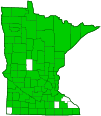moist sowthistle
(Sonchus arvensis ssp. uliginosus)
Conservation • Weed • Wetland • Description • Habitat • Ecology • Use • Distribution • Taxonomy
Description |
||
Moist sowthistle is a 16″ to 60″ tall, erect, perennial forb that rises on one or more stems from a deep, branched rhizome and creeping roots. The stems are erect, hollow between the nodes, hairless at least below the inflorescence, and often somewhat covered with a whitish, waxy bloom (glaucous). They occasionally branch near the top. The base of the stem is hard, sometimes woody. When broken the stems exude a white milky sap. Middle stem leaves are alternate, oblong to lance-shaped, 2⅜″ to 15¾″ long, and ¾″ to 6″ wide. They are irregularly, deeply lobed (pinnatifid) with 2 to 5 more or less triangular lobes per side. At the base of the leaf blade is a pair of ear-like projections (auricles) that wrap around no more than half of the stem. The auricles are small and usually rounded, sometimes pointed. The upper surface of the leaf blade is hairless and dull or only slightly shiny. The lower surface is hairless. The margins have sharp, spreading teeth with prickles at the tip. Basal and lower stem leaves are similar and are on winged leaf stalks. Upper leaves become gradually smaller, less lobed or unlobed, and have more prominent auricles. The inflorescence is a small, sparingly branched array of up to 20 flower heads at the end of the stem. The stalks of the inflorescence are long and hairless or occasionally sparsely to densely covered with minute, cobwebby or wooly hairs toward the tip (just under the flower head). They do not have glandular hairs. The flower heads are 1″ to 1¾″ in diameter when fully open. The whorl of bracts at the base of the flower head (involucre) is 9 ⁄16″ to ⅞″ long and either contracted at the tip (bell-shaped) or not contracted at the tip (pitcher-shaped). It is hairless or occasionally sparsely to densely covered toward the base with minute, cobwebby or wooly hairs. They do not have glandular hairs. Each flower head has 150 to 235 or more bright yellow to orangish-yellow ray florets and no disk florets. The ray florets are ⅜″ to 1″ long and have 5 small teeth at the tip. The flat, spreading, strap-like portion at the end of the ray floret is about as long as the tube portion at the base. The flowers are fragrant. They open 2 or 3 hours after sunrise and close around noon. The fruit is a ⅛″ long achene with 5 to 8 prominent ribs on each face and a wrinkled surface. There is a tuft of microscopically barbed hairs at the tip. |
||
Height |
||
16″ to 60″ |
||
Flower Color |
||
Yellow |
||
Similar Species |
||
Common sowthistle (Sonchus oleraceus) leaf auricles are triangular to lance-shaped and usually sharply pointed, rarely rounded. The lower surface of the leaf blade is pale and usually glaucous. The flower heads are smaller, ⅝″ to 1″ in diameter. The involucre is shorter, ⅜″ to ½″ long. The ray florets are shorter, 5 ⁄16″ to ⅝″ long. The achene is 3 to 5 ribbed. Field sowthistle (Sonchus arvensis ssp. arvensis) branches of the inflorescence are glandular-hairy, at least near the tip. The involucral bracts have a central stripe of glandular hairs. Prickly lettuce (Lactuca serriola) leaves have a row of prickles along the midvein on the underside. Prickly sow thistle (Sonchus asper) stem is soft at the base, not woody. The leaf auricles are always rounded, never pointed, and often wrap around more than half of the stem. The upper surface of the leaf blade is shiny. The lower surface is pale and usually glaucous. The flower heads are smaller, ⅝″ to 1″ in diameter. The involucre is shorter, ⅜″ to ½″ long. The ray florets are shorter, 5 ⁄16″ to ⅝″ long. The achene is prominently 3- ribbed and is not wrinkled. Thistle (Cirsium spp., Carduus spp.) stems and leaves do not have milky sap. |
||
Habitat |
||
Urban areas, roadsides, streambanks. disturbed areas. |
||
Ecology |
||
Flowering |
||
July to October |
||
Pests and Diseases |
||
|
||
Use |
||
|
||
Distribution |
||||
|
Sources |
|||
| 4/1/2023 | ||||
Nativity |
||||
Native to Africa, Asia, and Europe. Introduced into the United States and naturalized. |
||||
Occurrence |
||||
Very common |
||||
Taxonomy |
|||
| Kingdom | Plantae (Plants) | ||
| Division | Tracheophyta (Vascular Plants) | ||
| Subdivision | Spermatophytina (Seed Plants) | ||
| Class | Magnoliopsida (Dicots) | ||
Order |
Asterales (Sunflowers, Bellflowers, Fanflowers, and Allies) | ||
Family |
Asteraceae (Sunflowers, Daisies, Asters, and Allies) | ||
| Subfamily | Cichorioideae (chicories, dandelions, and allies) | ||
| Tribe | Cichorieae (lettuce, chicory, dandelion, and salsify) | ||
| Subtribe | Hyoseridinae | ||
| Genus | Sonchus (sow thistles) | ||
| Species | Sonchus arvensis (perennial sow thistle) | ||
Subordinate Taxa |
|||
|
|||
Synonyms |
|||
Sonchus arvensis var. glabrescens Sonchus uliginosus |
|||
Common Names |
|||
field sow thistle field sow-thistle field sowthistle marsh sowthistle moist sowthistle perennial sowthistle perennial sow-thistle sowthistle |
|||
Glossary
Achene
A dry, one-chambered, single-seeded seed capsule, formed from a single carpel, with the seed attached to the membranous outer layer (wall) only by the seed stalk; the wall, formed entirely from the wall of the superior ovary, does not split open at maturity, but relies on decay or predation to release the contents.
Auricle
A small, ear-like projection at the base of a leaf or at the junction of a grass blade and stem.
Glandular hairs
Hairs spread over aerial vegetation that secrete essential oils. The oils act to protect against herbivores and pathogens or, when on a flower part, attract pollinators. The hairs have a sticky or oily feel.
Glaucous
Pale green or bluish gray due to a whitish, powdery or waxy film, as on a plum or a grape.
Involucre
A whorl of bracts beneath or surrounding a flower, flower head, or flower cluster.
Node
The small swelling of the stem from which one or more leaves, branches, or buds originate.
Pinnatifid
Deeply cut, more than half way to the midrib but not to the midrib, into lobes that are spaced out along the midrib; the lobes do not form separate leaflets.
Rhizome
A horizontal, usually underground stem. It serves as a reproductive structure, producing roots below and shoots above at the nodes.
Wing
A thin, flat, membranous, usually transparent appendage on the margin of a structure.
Visitor Photos |
|||||
Share your photo of this plant. |
|||||
| This button not working for you? Simply email us at info@MinnesotaSeasons.com. Attach one or more photos and, if you like, a caption. |
|||||
|
|||||
MinnesotaSeasons.com Photos |
|||||
Plant |
|||||
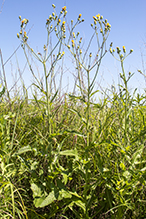 |
|||||
Flower Head |
|||||
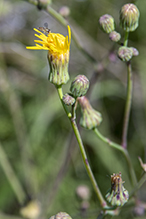 |
|||||
Leaf |
|||||
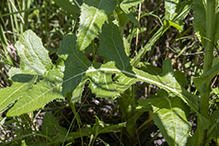 |
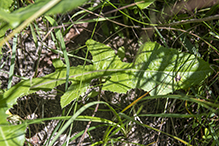 |
||||
Rounded Auricle |
|||||
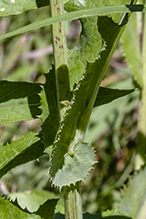 |
|||||

Slideshows |
||

Visitor Videos |
|||
Share your video of this plant. |
|||
| This button not working for you? Simply email us at info@MinnesotaSeasons.com. Attach a video, a YouTube link, or a cloud storage link. |
|||
Other Videos |
|||

Visitor Sightings |
|||||
Report a sighting of this plant. |
|||||
| This button not working for you? Simply email us at info@MinnesotaSeasons.com. Be sure to include a location. |
|||||
|
|||||
MinnesotaSeasons.com Sightings |
|||||

|
Created: Last Updated: © MinnesotaSeasons.com. All rights reserved. |
